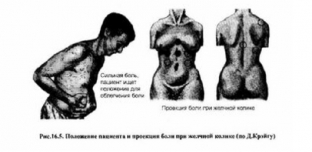Cholelithiasis is the third most common disease on the planet, second only to diseases of the cardiovascular system and diabetes. Statistics say that about 20% of women and 10% of men after 40 years of age are subject to this pathology. The formation of stones in the gallbladder is due to disorders of the metabolism of bilirubin and cholesterol. But in each individual case, the size, shape and number of stones formed are strictly individual, namely, the clinical picture and symptoms of gallstone disease that occur in each individual case depend on these factors.
Stages of cholelithiasis according to the course of the disease
Classification of cholelithiasis involves the division of the disease into certain stages, depending on the location, number and size of stones formed, which is of fundamental importance for the symptoms of cholelithiasis.
The following stages of gallstone disease are distinguished:
- Initial stage – physical and chemical changes occur in the gallbladder.
- Stage of stone formation – latent asymptomatic course of the disease or simply stone bearing.
- Clinical stage – calculous cholecystitis and complications of cholelithiasis.
Classifications of cholelithiasis depending on the characteristics of stones
Depending on the clinical course of cholelithiasis, localization, number and size of formed stones, the following forms of cholelithiasis are distinguished:
Classification by clinical course:
- asymptomatic gallstones;
- symptomatic without complications;
- complicated cholelithiasis.
Classified by location:
- stones of the fundus and body of the gallbladder;
- stones in the neck of the gallbladder.
Classification by number of stones formed:
- single gallstones;
- multiple gallstones.
Classification by stone size:
- microlites – up to 2 mm;
- small stones – up to 1 cm;
- medium stones – up to 3 cm;
- large stones – more than 3 cm.
Biliary colic – characteristic symptoms of cholelithiasis
Pain syndrome is the most characteristic symptom of cholelithiasis and is most often manifested by an attack of biliary colic. This condition occurs most often under the influence of provoking factors: after eating, especially heavy food, taking choleretic drugs, after physical exertion or work in an inclined position. Biliary colic is characterized by the presence of intense painful sensations that are localized in the epigastrium, right hypochondrium, and in some cases can radiate to the back. Most often, an attack of biliary colic occurs in the evening or at night and can last from 15 minutes to several hours, while attacks of biliary colic can be repeated at different intervals.

Other common symptoms of gallstone disease
In addition to biliary colic, patients with cholelithiasis quite often experience symptoms of biliary dyspepsia, which include:
- a feeling of heaviness and discomfort in the right hypochondrium;
- nausea and less often vomiting;
- a feeling of bitterness in the mouth;
- disturbance of appetite;
- feeling disgusted with fatty heavy foods;
- constipation and diarrhea as manifestations of stool disorders;
- flatulence and flatulence.
In about 30% of patients with gallstone disease, often those with single gallstones, the disease may be asymptomatic and the stone is discovered incidentally on ultrasound. Such stones in the gallbladder are called "dumb" stones.
What conditions can complicate gallstone disease
An attack of biliary colic, which lasts more than 5 hours, should alert in terms of the occurrence of possible complications of gallstone disease. Often, a stone can enter the cystic duct, blocking it and creating conditions for the attachment of an infectious process and the development of acute cholecystitis.
 If the stone penetrates the common bile duct, choledocholithiasis develops – blockage of the duct, which, if not treated promptly, leads to cholangitis and the possible development of sepsis. Often choledocholithiasis is complicated by biliary pancreatitis, which significantly worsens the patient's condition. In severe cases, perforation of the gallbladder may occur with the development of biliary peritonitis or biliary fistula, through which stones enter the intestinal cavity. Knowing the symptoms of gallstone disease and promptly seeking qualified medical help will help prevent the occurrence of complications.
If the stone penetrates the common bile duct, choledocholithiasis develops – blockage of the duct, which, if not treated promptly, leads to cholangitis and the possible development of sepsis. Often choledocholithiasis is complicated by biliary pancreatitis, which significantly worsens the patient's condition. In severe cases, perforation of the gallbladder may occur with the development of biliary peritonitis or biliary fistula, through which stones enter the intestinal cavity. Knowing the symptoms of gallstone disease and promptly seeking qualified medical help will help prevent the occurrence of complications.







Add a comment